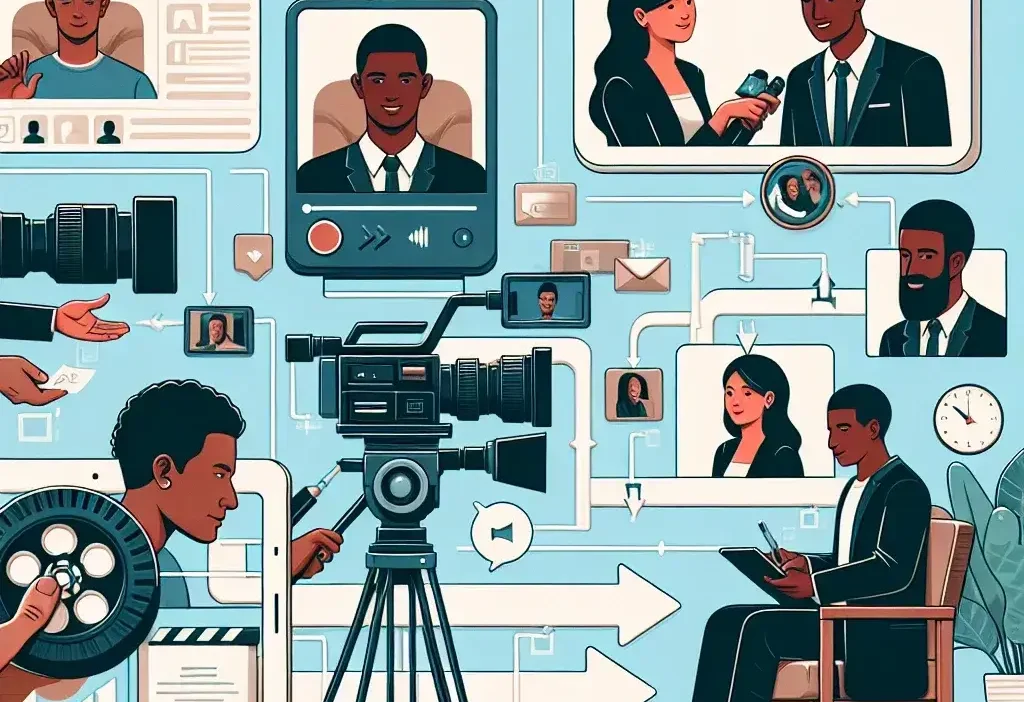Creating compelling video content that combines interviews with supplementary visual elements requires careful planning and execution. The art of merging interviews with b-roll footage and slides transforms static talking-head videos into dynamic, engaging narratives that captivate audiences and effectively communicate your message.
Understanding the Foundation: What Are B-Roll and Slides?
Before diving into the merging process, it’s essential to understand each component. B-roll footage refers to supplementary video material that supports your main interview content. This might include shots of the interviewee at work, relevant environments, product demonstrations, or abstract visuals that reinforce spoken concepts. Slides, on the other hand, encompass static visual elements like graphics, charts, text overlays, photographs, or presentation materials that provide additional context or emphasis to the spoken word.
The strategic combination of these elements creates a multi-layered viewing experience that keeps audiences engaged while reinforcing key messages through multiple sensory channels.
Pre-Production Planning: Setting the Stage for Success
Successful integration begins long before you sit down at the editing console. During the pre-production phase, consider how your b-roll and slides will complement your interview content. Create a detailed shot list that identifies specific moments where visual support would enhance understanding or maintain viewer interest.
When planning your interview questions, think about natural transition points where b-roll footage or slides would feel organic rather than forced. For instance, when discussing a company’s growth trajectory, having charts and graphs ready provides immediate visual context that supports the narrative.
Organizing Your Assets
Develop a systematic approach to organizing your media files. Create clearly labeled folders for interview footage, b-roll clips, slide materials, and audio files. This organization becomes crucial during the editing process when you need to quickly locate specific assets to maintain creative momentum.
Technical Considerations for Seamless Integration
The technical aspects of merging these elements require attention to detail and consistency. Ensure all your footage maintains similar quality standards in terms of resolution, frame rate, and color grading. Mismatched technical specifications can create jarring transitions that distract from your content’s message.
Audio Synchronization
Maintaining consistent audio levels across all elements is paramount. Your interview audio should remain the primary focus, with any audio from b-roll footage serving as subtle background enhancement rather than competing for attention. Use audio ducking techniques to automatically lower b-roll audio when interview subjects are speaking.
Consider recording room tone during your interview session – this ambient sound can bridge gaps between different video segments, creating smoother transitions when cutting between interview footage and b-roll material.
Editing Workflow: The Art of Seamless Transitions
The editing process requires a methodical approach that prioritizes story flow over technical flashiness. Begin by creating a rough cut of your interview, identifying the strongest sound bites and organizing them into a logical narrative sequence. This foundation provides the skeleton upon which you’ll layer your visual enhancements.
Timing and Pacing
Understanding timing is crucial for effective integration. Generally, b-roll shots should last between 3-10 seconds, depending on the complexity of the visual information and the pace of the accompanying narration. Slides containing text or detailed graphics may require longer screen time to allow viewers to absorb the information.
Avoid rapid-fire cutting between elements, as this can create a disorienting viewing experience. Instead, allow each visual element sufficient time to support and enhance the spoken content without overwhelming the audience.
Transition Techniques
Master various transition methods to create smooth flows between different visual elements. Cut transitions work well for quick changes that maintain energy, while fade transitions provide gentler shifts that allow viewers to process information. Wipe transitions can effectively introduce slides or graphics without disrupting the interview’s natural rhythm.
Creative Storytelling Through Visual Layering
The most effective merged content tells a cohesive story where each element serves a specific narrative purpose. Your interview provides the verbal foundation, b-roll footage offers visual proof or context, and slides deliver supporting data or conceptual illustrations.
Consider the emotional journey you want to create for your viewers. Use b-roll footage to establish mood and environment, while strategically placed slides can emphasize key statistics or important concepts. This layered approach creates depth that single-element videos cannot achieve.
Maintaining Visual Hierarchy
Establish clear visual hierarchy to guide viewer attention effectively. Your interview subject should typically occupy the primary visual space, with b-roll and slides serving supporting roles. When slides contain critical information, consider using picture-in-picture techniques to maintain the human connection while presenting data.
Advanced Techniques for Professional Results
Experienced editors employ sophisticated techniques to create seamless integration that appears effortless to viewers. Match cutting involves transitioning between similar visual elements or movements to create visual continuity. For example, cutting from an interviewee’s hand gesture to b-roll footage of hands working creates subconscious connections.
Parallel editing allows you to cut between interview content and related b-roll footage that illustrates the speaker’s points in real-time. This technique particularly effective for process explanations or storytelling segments.
Color Grading and Visual Consistency
Maintain visual consistency across all elements through careful color grading. Your interview footage, b-roll clips, and slide graphics should share similar color temperatures and contrast levels. This consistency creates a professional appearance that enhances credibility and viewer engagement.
Common Pitfalls and How to Avoid Them
Several common mistakes can undermine the effectiveness of merged content. Over-editing represents perhaps the most frequent error, where editors include too many visual elements that compete for attention rather than supporting the core message. Remember that sometimes less is more – strategic restraint often produces more powerful results than visual excess.
Mismatched pacing between verbal content and visual elements can create confusion or boredom. Ensure your visual cuts align with natural speech patterns and content breaks rather than arbitrary timing intervals.
Technical inconsistencies in audio levels, video quality, or color grading immediately signal amateur production values to viewers. Invest time in technical standardization to maintain professional credibility throughout your content.
Tools and Software Recommendations
Professional video editing software provides the precision tools necessary for effective merging. Industry-standard applications like Adobe Premiere Pro, Final Cut Pro, or DaVinci Resolve offer sophisticated features for multi-track editing, color correction, and audio management.
For those working with limited budgets, capable alternatives like Filmora or OpenShot provide sufficient functionality for basic merging projects while maintaining professional output quality.
Quality Control and Final Review
Before finalizing your merged content, conduct thorough quality control reviews. Watch your video multiple times, focusing on different aspects during each viewing – audio levels during one pass, visual transitions during another, and overall narrative flow during a final review.
Consider seeking feedback from colleagues or target audience members who can provide objective perspectives on your content’s effectiveness and clarity.
Measuring Success and Iteration
Track viewer engagement metrics to understand how effectively your merged content resonates with audiences. Pay attention to watch time, engagement rates, and viewer feedback to identify successful techniques and areas for improvement.
Use this data to refine your approach for future projects, gradually developing a personal style that effectively combines interviews, b-roll footage, and slides into compelling video narratives.
The mastery of merging interviews with b-roll and slides represents a valuable skill in today’s content-driven marketplace. Through careful planning, technical attention to detail, and creative storytelling approaches, you can create video content that not only informs but truly engages your audience, establishing stronger connections and more effective communication outcomes.




